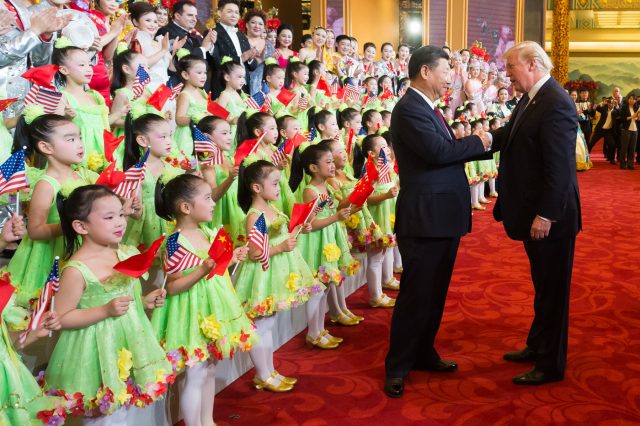Religious freedom is an economic asset, certainly to the U.S. but also to China. As Trump & Xi meet in Argentina at the annual G20 economic summit, below are some points to ponder.
Religious freedom: Asset to economic recovery and growth
As the world navigates away from years of poor economic performance, religious freedom is an unrecognized asset to economic recovery and growth, being one of only three factors significantly associated with global economic growth, according to a 2014 study. The study looked at GDP growth for 173 countries in 2011 and controlled for two-dozen different financial, social, and regulatory influences. The study also examines and finds a positive relationship between religious freedom and ten of the twelve pillars of global competitiveness, as measured by the World Economic Forum’s Global Competitiveness Index (link).
Religious Freedom: Sets Faith Groups Free to Help Tackle Poverty
Poverty, some argue, can only be effectively tackled by governments enforcing top-down, big-P Poverty reduction policies and programs. But a host of religious groups empowered by religious freedom haven’t gotten the memo. Innovative faith-based initiatives worldwide are tackling poverty using bottom-up, small-p poverty alleviation approaches that empower individuals to be resourceful, resilient and self-reliant. Indeed, a central aspect of religious freedom is that it gives faith groups license to innovate and contribute to the wellbeing of individuals, communities and nations. But where religious freedom is curtailed, so are such innovations. For instance, reform-minded Saudi princess Basmah bint Saud argues, religion “should not be a shield behind which we hide from the world but a driving force that inspires us to innovate and contribute to our surroundings.” See examples of poverty reduction set free by religious freedom at this link.
Religious Freedom Yields $1.2T US Religious Economy
Safeguards for religious freedom have helped to produce a dynamic religious environment in the United States that contributes socially and economically according to a 2016 study. Socially, religious groups provide over 1.5 million different social services, such as faith-based job training programs. This religious freedom also contributes $1.2 Trillion dollars to the US economy annually. That is equivalent to U.S. religion being the world’s 15th largest national economy, putting it ahead of about 180 other countries. It’s more than the annual revenues of the world’s top 10 tech companies, including Apple, Amazon and Google. And it’s also more than 50% larger than that of the annual global revenues of America’s 6 largest oil and gas companies. So, you might say, that represents a lot of spiritually inspired fuel being pumped into the U.S. economy. See study and short video highlighting the results at this link.
China’s Religious Liberalization After Cultural Revolution Creates Economic Asset
A Pew Research Center religious diversity study – based on methodology I developed with Todd Johnson – finds that about one-in-three people live in countries with high religious diversity (also see Chapter 3 in our book, The World’s Religions in Figures).
 While the majority of the world’s countries (59%) have relatively low religious diversity, because many countries with low diversity have small populations, only a third (33%) of the world’s people live in them according to the study. About a third (32%) of the world’s people live in countries with moderate religious diversity and another third (35%) live in countries with high or very high religious diversity.
While the majority of the world’s countries (59%) have relatively low religious diversity, because many countries with low diversity have small populations, only a third (33%) of the world’s people live in them according to the study. About a third (32%) of the world’s people live in countries with moderate religious diversity and another third (35%) live in countries with high or very high religious diversity.
China has a very diverse mixture of the eight major religious groups counted in the Pew study: Buddhists (18.2%), Christians (5.1%), unaffiliated (52.2%), Muslims (1.8%), other religions (0.7%), Hindus (<1%), folk religionists (21.9%) and Jews (<1%).
During the Cultural Revolution of the 1960s and 1970s, religion was completely outlawed and people were routinely beaten and killed for having superstitious or religious beliefs. While it is true that today China has very high government restrictions on religion relative to other countries in the world, current conditions are far less restrictive than they were in the 1960s and 1970s.
Today, China has the world’s largest Buddhist population, largest folk religionist population, largest Taoist population, 9th largest Christian population and 17th largest Muslim population – ranking between Yemen and Saudi Arabia (Pew Research Center 2012).
 Acknowledging China’s very high religious diversity is important because countries with higher levels of religious diversity are more globally competitive. China’s very high religious diversity contributes to the country’s remarkable economic growth, which has not only fueled global growth but also lifted more than 500 million people out of abject poverty.
Acknowledging China’s very high religious diversity is important because countries with higher levels of religious diversity are more globally competitive. China’s very high religious diversity contributes to the country’s remarkable economic growth, which has not only fueled global growth but also lifted more than 500 million people out of abject poverty.
Globally, what do the data say about the relationship between religious diversity and global competitiveness? We can see clearly that countries with higher levels of religious diversity are on average significantly more globally competitive by comparing the Religious Diversity Index (RDI) scores of the top 27 economies on the World Economic Forum’s Global Competitiveness Index (GCI) with the 110 lower ranking economies (China is ranked 27th), as shown in the table below. The median RDI for the top 27 economies is 5.4 compared with a median of 2.5 for the remaining 110 economies for which the World Economic Forum calculates a GDI score. Looked at another way, 59% of the top economies (16 of 27) have high or very high religious diversity compared with just 17% of the remaining 110 economies (19 of 110).

